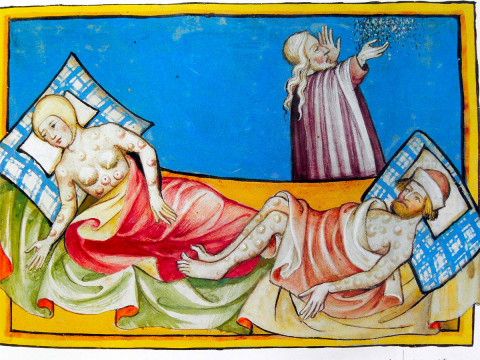
In the annals of human history, few events have wrought such profound and far-reaching impacts as the Black Death. Sweeping across Europe, Asia, and North Africa between 1347 and 1351, this devastating pandemic caused the deaths of an estimated 75 to 200 million people, decimating roughly 30-60% of Europe’s population. The Black Death was not merely a health crisis but a cataclysmic event that reshaped societies, economies, and cultures in ways that resonate to this day. This essay explores the origins and spread of the Black Death, its immediate and long-term impacts on medieval society, and the transformative changes it precipitated in European history.
Origins and Spread of the Black Death
The Black Death is widely believed to have originated in the arid plains of Central Asia, where it likely festered in rodent populations. The bacterium responsible for the plague, Yersinia pestis, was transmitted to humans through the bite of infected fleas that lived on black rats. The pandemic made its way westward along the Silk Road, a vital network of trade routes that connected the East and West. In 1347, the plague reached Crimea, from where it was carried by merchant ships to Europe.
The rapid spread of the Black Death was facilitated by the very trade networks that underpinned medieval economies. As ships carrying goods also harbored rats and fleas, the disease quickly moved from port to port. By the end of 1347, the plague had arrived in Sicily, and within a year, it had spread to the Italian mainland, France, Spain, and beyond. The speed and extent of its spread were unprecedented, driven by the high population densities and unsanitary conditions of medieval cities.
Immediate Impact of the Black Death
The immediate impact of the Black Death was nothing short of apocalyptic. Towns and villages were decimated as the disease spread like wildfire, killing indiscriminately. The symptoms of the bubonic plague were horrifying: sudden fever, painful swellings (buboes) in the groin, neck, or armpits, and the appearance of black spots on the skin due to subcutaneous hemorrhages. Death usually followed within a week of the first symptoms.
The mortality rate was staggering, and in some areas, entire communities were wiped out. The high death toll led to severe labor shortages, as a significant portion of the working population perished. Fields went unplowed, crops rotted in the ground, and famine loomed as agricultural production plummeted. The breakdown of social and economic structures was immediate and profound.
Public health responses were rudimentary at best. With little understanding of the disease’s transmission, people resorted to desperate measures. Some cities imposed quarantines, while others turned to religious processions and penance, hoping to appease what many believed was divine wrath. The inability of contemporary medicine to provide effective treatments only heightened the sense of helplessness and despair.
Social and Cultural Upheaval
The Black Death precipitated significant social and cultural upheaval. The sheer scale of mortality forced people to confront the fragility of life and the ubiquity of death. This was reflected in the art and literature of the time, which often depicted macabre themes. The danse macabre, or dance of death, became a popular motif, illustrating the inescapable nature of death that spared no one, regardless of status or wealth.
Religiously, the pandemic shook the foundations of medieval faith. The Church, which had been a central institution in daily life, appeared powerless to stop the spread of the plague. This led to a crisis of faith for many, as people questioned the efficacy of religious rituals and the morality of the clergy, some of whom fled their posts to escape the disease. At the same time, religious fervor increased in other quarters, with movements such as the flagellants, who believed that public acts of penance would stave off divine punishment.
The societal impact was also marked by increased persecution of minority groups. Jews, in particular, were scapegoated and accused of poisoning wells to spread the plague. This led to widespread pogroms and massacres, further fueling social instability and highlighting the deep-seated prejudices that existed within medieval society.
Economic Consequences
The economic consequences of the Black Death were profound and far-reaching. The dramatic reduction in the population created labor shortages, which in turn disrupted traditional feudal economies. With fewer serfs and peasants to work the land, landlords faced declining revenues. In many regions, this led to the breakdown of the manorial system that had characterized medieval agriculture.
Survivors found themselves in a stronger bargaining position, as the scarcity of labor allowed them to demand better wages and working conditions. This shift in the balance of power between labor and landowners contributed to the decline of serfdom in Western Europe. Peasants and workers could now move more freely, seeking out better opportunities, which in turn led to the rise of a more mobile and dynamic labor market.
The Black Death also had significant impacts on urban economies. The high mortality rate among artisans and tradespeople disrupted production and trade. However, the resulting scarcity of goods led to higher prices, benefiting those who survived and could continue their businesses. In the long term, the reduction in population led to a surplus of goods and resources, contributing to a rise in living standards for many survivors.
Political and Institutional Changes
In some regions, the Black Death led to political instability and uprisings. Peasant revolts, such as the Jacquerie in France and the Peasants’ Revolt in England, were fueled by the economic hardships and social upheavals caused by the plague. These revolts, though often brutally suppressed, highlighted the growing discontent among the lower classes and the pressures on the feudal system.
The political landscape of Europe was also transformed by the Black Death. The dramatic population decline weakened the power of the feudal nobility, as their economic base—land and serf labor—was severely disrupted. In contrast, centralized monarchies began to consolidate power, as the need for effective governance in the face of crisis became more apparent.
Institutionally, the Church faced significant challenges. The loss of many clergy members to the plague and the subsequent questioning of the Church’s authority led to calls for reform. This period of crisis sowed the seeds for later movements, such as the Protestant Reformation, which would profoundly reshape the religious landscape of Europe.
Long-term Effects and Transformations
While the immediate impacts of the Black Death were catastrophic, the long-term effects were transformative. One of the most significant outcomes was the demographic shift that followed the pandemic. With a drastically reduced population, there was less competition for resources, leading to improved living standards for many. Wages rose, and the price of land fell, making it more accessible to a broader segment of the population.
The labor shortages also spurred technological innovation and changes in agricultural practices. With fewer workers available, there was a greater incentive to adopt labor-saving technologies and more efficient farming methods. This contributed to an increase in agricultural productivity over time and laid the groundwork for future economic developments.
Culturally, the Black Death had a profound impact on European thought and philosophy. The omnipresence of death and the collapse of social and religious certainties led to a more questioning and empirical approach to understanding the world. This shift in mindset was one of the factors that contributed to the intellectual and cultural revival of the Renaissance. The emphasis on human experience, observation, and inquiry that characterized the Renaissance can be seen, in part, as a response to the failures and horrors of the Black Death.
The Black Death and Modern Lessons
The Black Death holds valuable lessons for the modern world, particularly in the context of global health and crisis management. One of the most critical lessons is the importance of public health infrastructure and preparedness. The medieval world was ill-equipped to deal with a pandemic of such magnitude, lacking the medical knowledge, organizational capacity, and coordinated response mechanisms that are essential in managing public health crises.
Modern advancements in medicine, epidemiology, and global communication have vastly improved our ability to respond to pandemics. However, the COVID-19 pandemic has shown that many of the challenges faced during the Black Death—such as misinformation, resource shortages, and social inequalities—remain relevant today. Effective pandemic response requires robust health systems, clear communication, and international cooperation, all of which were lacking in the medieval response to the Black Death.
Another important lesson is the need to address the social and economic inequalities that pandemics exacerbate. The Black Death disproportionately affected the poor and marginalized, a pattern that has been seen in modern pandemics as well. Ensuring equitable access to healthcare, social support, and economic opportunities is crucial in mitigating the long-term impacts of such crises.
Conclusion
The Black Death stands as the greatest crisis faced by humanity in the past, not only because of its staggering death toll but also due to its profound and lasting impacts on society, economy, and culture. The pandemic reshaped the medieval world, dismantling old structures and paving the way for new social, economic, and intellectual developments. The transformations that emerged from the ashes of the Black Death set the stage for the modern world, highlighting the resilience and adaptability of human societies in the face of catastrophic challenges.
In understanding the Black Death, we gain insights into the dynamics of pandemics and their far-reaching consequences. The lessons learned from this historical event are invaluable as we navigate the complexities of the modern world and confront the challenges of our own time. As we reflect on the past, we are reminded of the importance of preparedness, equity, and innovation in building a more resilient and just society for the future.
By: Somabha Sadhu
Write and Win: Participate in Creative writing Contest & International Essay Contest and win fabulous prizes.


